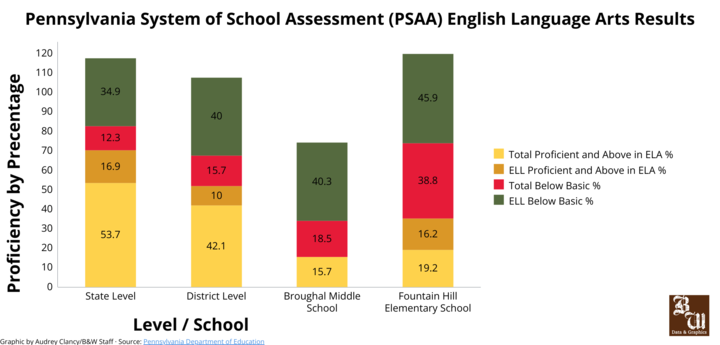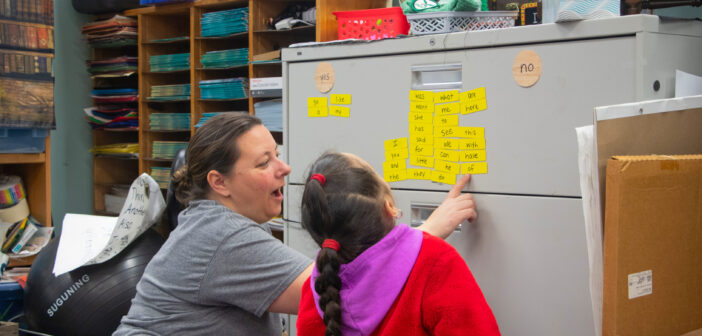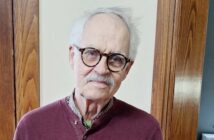According to the 2022 census, 11.8% of families in Pennsylvania spoke a language other than English at home. In Bethlehem specifically, 25% of household families’ primary language was not English.
To support language differences inside classrooms, the state of Pennsylvania mandates school districts to provide a curated program for students whose first language is not English, also referred to as English Language Learners (ELLs).
Among the Bethlehem Area School District’s 14,000 students, the 1,212 ELLs are a part of the English for Speakers of Other Languages (ESOL) program and provide a look into the realities of learning in a secondary language.
Jose Sanchez, the Bethlehem School District’s supervisor of English Language Services, said the number of ELLs has been increasing in recent years.
In order to help ELLs with language proficiency, Bethlehem schools have ESOL teachers. Sanchez said the typical ratio of ESOL students to teachers is 25-to-1.
Sanchez said the ESOL programs vary at different levels. The elementary school level consists of ESOL teachers working with students for short periods of time once or twice a day. At the middle school level, students have sheltered English instruction — learning provided to ESOL students away from the general classes with lesson plans modified to meet their needs — while learning other subjects in general classrooms. For high school students, all subjects are taught with an ESOL teacher.
Amanda Ortwein and Keila Olmeda are two ESOL teachers at Fountain Hill Elementary School who work to better their students’ English language proficiency.
Ortwein said of the approximately 500 students at Fountain Hill, 97 are part of the ESOL program, speaking a variety of languages, with the three most common being Spanish, Portuguese and French. She said Fountain Hill has a relatively high ESOL student population with approximately 20% of students enrolled.
Olmeda said the elementary level does small group instruction with students at similar levels of English proficiency. Ortwein said they will occasionally sit in with their students in the classroom, supporting and helping them with whatever they may need.
Carolina Velasquez is a seventh-grade English as a Second Language (ESL) teacher at Broughal Middle School, where there are 78 ESL students out of approximately 500 students. Students whose secondary language is English are screened to determine their English proficiency and placed into levels based on their score. She said there are about 21 students at Broughal in the first level, which is the lowest level of the four levels of English proficiency.
Velasquez said teachers of students with little English knowledge have access to “Can Do Descriptors.”
Can Do Descriptors describe the students’ skills in four categories: reading, listening, speaking and writing. Ortwein said Can Do Descriptors act as a guide for teachers of what ELL students should be able to understand at different levels.
“A lot of times their listening and speaking skills develop a lot faster than their reading and writing skills,” Ortwein said. “So it kind of breaks it down by category for us.”
Sanchez said ELLs take the World Class Instructional Design and Assessment (WIDA) ACCESS test every year that evaluates their speaking, reading, listening and writing skills. He said if students achieve a minimum score of 4.5, the ESOL teachers then determine if the student is ready to continue school without ESOL support.
Sanchez said last year approximately 16% of level four ESOL students met this threshold and were reclassified as no longer needing ESOL instruction.
The WIDA is not the only test taken by ELLs. The Pennsylvania System of School Assessment (PSSAs) are administered each year to all public school students, testing English Language Arts, Math and Science.
In 2023, 40% of ELLs in the Bethlehem Area School District tested at a below-basic level on the English Language Arts exam. Around 46% of ELLs at Fountain Hill and 40.3% of ELLs at Broughal tested below basic on the English Language Arts portion.
 Sanchez said new students in the ESOL program are not required to take the reading portion of the PSSA their first year. He said for the rest of the students, accommodations to help them understand the test are fairly limited.
Sanchez said new students in the ESOL program are not required to take the reading portion of the PSSA their first year. He said for the rest of the students, accommodations to help them understand the test are fairly limited.
“Accommodations may be small group instruction or testing within a small group environment,” Sanchez said. “Because it’s a reading assessment, we can’t read anything to them. We can read the directions to them, but that’s pretty much it.”
Sanchez said this differs from the math portion of the exam, where for the first three years students are able to take the test in Spanish. He said the PSSAs are only translated into Spanish, so students who speak another language will often work on the exam with interpreters.
WIDA test scores, input from their ESOL teachers and daily classroom performance are important factors that Sanchez said are taken into account for a successful holistic education.
“The PSSA is just one small aspect of information that we use,” Sanchez said, “but it’s not the driving force to deliver how we’re going to create the instructions and lessons for the student.”
Olmeda said the WIDA is an accurate measure of students’ English proficiency because it shows progress in language development even if the student is not performing on grade level according to the PSSA.
Ortwein said they also monitor students with Acadience tests, which includes a one-minute reading of a passage followed by a retell test that measures their fluency and comprehension.
“That’s something we do regularly that can show their growth,” Ortwein said. “I would say that probably shows a better picture of their reading skills than the PSSA.”
Sanchez said the future of the ESOL program could be impacted by technological development and translation tools, such as artificial intelligence. These tools are already being used to bridge the language gap.
Olmeda said teachers will try as much as possible to communicate with non-English speakers, mainly with Google Translate. However, she said technology is not always the solution.
Olmeda, who is fluent in Spanish, said the variety in how things are communicated across the 13 Spanish-speaking countries where the Fountain Hill students are from means Google Translate is not always a feasible way to solve the language gap.
“If they put too much information in at once, Google Translate doesn’t translate correctly,” Olmeda said, “But they try. They have the best interest for the students and at least try to do something.”
Sanchez said there are typically one to two professional developments for teachers each year to guide them in modifying their instruction while working closely with the ESOL teachers to support them in bridging the language gap.
“Our program and enrollment continues to grow,” Sanchez said. “We’re providing the best education that we can. As the years go, we need to evaluate, change and adapt and make sure we’re doing our job of meeting every students’ needs.”






Comment policy
Comments posted to The Brown and White website are reviewed by a moderator before being approved. Incendiary speech or harassing language, including comments targeted at individuals, may be deemed unacceptable and not published. Spam and other soliciting will also be declined.
The Brown and White also reserves the right to not publish entirely anonymous comments.